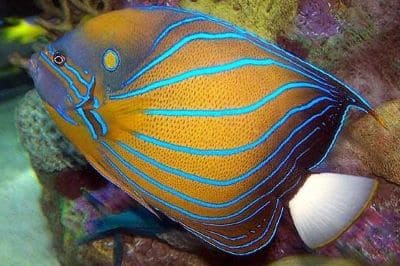Home › A-Z Destinations › Asia › Thailand › Koh Tao › Hin Wong Bay
Scuba Diving the Hin Wong Dive Site
There's a superabundance of stunning dive sites in Koh Tao, and choosing a favourite spot to scuba dive or snorkel is not going to be easy.
This guide contains useful information about the diving at Hin Wong Bay on the east coast of the island, with extra details about the resident marine life.
What Months are Best for Diving in Koh Tao
In fact, the Chumphon Archipelago contains dozens of sun-kissed bays on the islands. But, the premier spots for divers and snorkelers are:
- Koh Phangan
- Koh Samui
- Mu Ko Chumphon National Park
- Turtle Island (aka Koh Tao)
Koh Tao is a compact kidney-shaped island that has about twenty one (21) square kilometres of total land mass.
Nevertheless, the pristine white sand beaches and azure blue water have transformed Koh Tao Island into one of the top places for a scuba diving holiday in Thailand.
Here's the deal:
Most scuba divers want to explore destinations that are sunny and have calm conditions underwater. Well, Koh Tao has over three hundred days of sunshine per year and the temperature of the water is fairly constant around 29° Celsius (84° Fahrenheit).
As a consequence of that, it's fair to say Koh Tao diving and snorkeling is an annual activity. But, divers need to be mindful that the southwest monsoons usually arrive towards the end of October and may continue until the end of January.
At certain times of the year, the south western gulf can have thirty (30) metres of underwater visibility. Hence, the best months for divers to enjoy clear water dives are July, August, and September.
Pro Tip: Check the sea life section for fun facts about whale sharks that often show up at Koh Tao Island in April and May.
Marine Life at Hin Wong Bay
Koh Tao dive sites are good places to see big fishes (e.g. pelagics). Plus, divers should expect to catch sightings of common marine life native to the lower Gulf of Thailand, especially during the plankton blooms in March and April, such as:
- Blue ring angelfish (Pomacanthus annularis)
 Christmas tree worm (Spirobranchus giganteus)
Christmas tree worm (Spirobranchus giganteus)- Emperor angelfish (Pomacanthus imperator)
- False moorish idol (schooling bannerfish)
- Fusilier fishes (Caesionidae)
- Jenkins' whipray (Pateobatis jenkinsii)
- Parrotfish
- Rabbitfishes (sometimes called spinefoots)
- Sea sponges (e.g. giant barrel sponge)
- Squirrelfish (Holocentrus adscensionis)
- Sergeant major fish (Abudefduf saxatilis)
- Yellow boxfish (Ostracion cubicus)
Pro Tip: The site offers good opportunities to explore sea life that lives around hard and soft corals. For example, the hard varieties include brain, table, and staghorn corals.
Tips for Diving at Hin Wong
It's fair to describe the large bay at Hin Wong as horseshoe or crescent shaped. As a consequence of that, it gets a fair amount of protection against strong winds and water currents.
Experienced divers will be able to choose between a number of different routes to explore, depending on the scuba certification levels.
Even though the maximum depth is about twenty metres, there are some shallow spots that novice snorkelers and free divers can enjoy too.
Hin Wong Bay North
The northern side of this broad inlet is a good place to roam around rugged cracks and crevices. This area provides an ideal underwater environment for marine life animals that prefer sheltered habitats, such as sea snakes and the yellow boxfish (Ostracion cubicum).
Similar to Artificial Reef dive site Khao Lak, the calm bay at Hin Wong contains some giant boulders and bommies that create chillout zones and hidey-holes for juvenile reef fishes and sleepy sea turtles.
Pro Tip: If you get the timing right you should see gatherings of blacktips (a species of requiem shark) on a daily basis.
Hin Wong Bay south
The best place for snorkeling tours and scuba beginners is the southern side of the indentation. Divers with sharp eyes should spot a small cave at the corner of the bay.
Pro Tip: Sheltered bays with areas of open sand and little water movement are ideal locations for local dive shops to conduct the Discover Scuba Diving program, and its related training dives. This kind of underwater topography also provides a superb backdrop for underwater photography, freediving, and learning how to snorkel.
Related Information and Help Guides
- Aow Leuk Dive Site Koh Tao for Diving and Snorkeling
- HTMS Sattakut Koh Tao Shipwreck Location and History
- Information about the Shark Island Dive Site at Koh Tao
- Laem Thian Dive Sites in Koh Tao for Beginners
- Is Chumphon Pinnacle the Best Place to Dive in Koh Tao?
- Sail Rock Dive Site in the Lower Gulf of Thailand
- Koh Samui Scuba Diving and Snorkeling Sites
- Where are the Best Shipwreck Dives in Thailand?
Pro Tip: This short clip [57 seconds] presented by "Black Turtle Dive" contains footage of the flamboyant sea life found at Hin Wong Bay diving site.